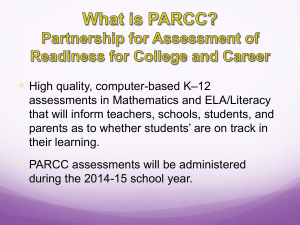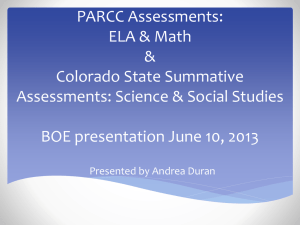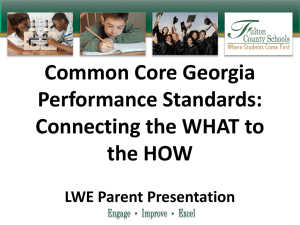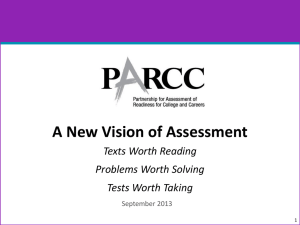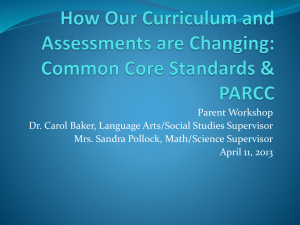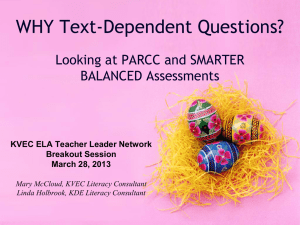PARCC ELA/Literacy Assessment Are we ready for 2014-2015
advertisement
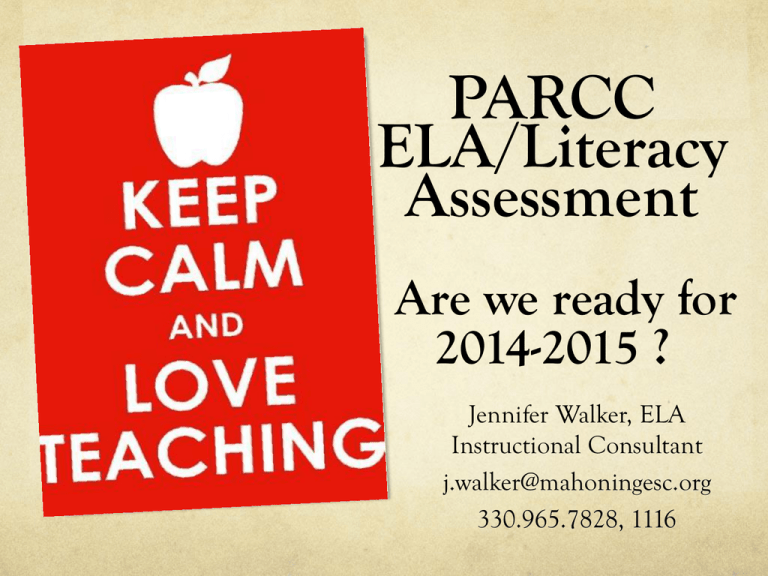
PARCC ELA/Literacy Assessment Are we ready for 2014-2015 ? Jennifer Walker, ELA Instructional Consultant j.walker@mahoningesc.org 330.965.7828, 1116 The Future of Assessments & the Implications for Our Teaching PARCC Assessment Information What Are the Three Shifts at the Heart of PARCC Design (and the Standards)? • Complexity: Regular practice with complex text and its academic language. • Evidence: Reading and writing grounded in evidence from text, literary and informational. • Knowledge: Building knowledge through content rich nonfiction. See PARCC PowerPoint Overview of the New ELA/Literacy Sample Items (scroll to the bottom of the page for the link) Assessment Design English Language Arts/Literacy and Mathematics, Grades 3-11 2 Optional Assessments/Flexible Administration Diagnostic Assessment •Early indicator of student knowledge and skills to inform instruction, supports, and PD •Non-summative Mid-Year Assessment •Performance-based •Emphasis on hard-tomeasure standards •Potentially summative Performance-Based Assessment (PBA) • Extended tasks • Applications of concepts and skills • Required Speaking And Listening Assessment •Locally scored •Non-summative, required End-of-Year Assessment •Innovative, computerbased items •Required Round 1 – Performance Based Assessments Focus of the Assessments Performance Based Assessments (PBA) (administered after approximately 75% of the school year) Writing effectively when analyzing text Performance Based Components Literary Analysis Research Simulation Narrative Expectations For each task, students will be asked to read one or more texts, answer several short comprehension and vocabulary questions. Students will write an essay that requires them to draw evidence from the text(s). Standards NOT Assessed in the PBAs Grade RL RI W SL 3 RL 6 RI 6 W9 SL 1-6 4 RL 6 SL 1-6 5 RL 6 SL 1-6 6 RL 6 SL 1-6 7-9 SL 1-6 10 RL 6 SL 1-6 11 RL 6 SL 1-6 • RL & RI 10 will be assessed through the complexity of the texts students will be given to read. • The Speaking & Listening Assessment has been postponed until 2015-2016. Round 2 – End-of-Year Summative Assessment Focus of the Assessments End-of-Year Summative Assessment (EOY) (administered after approximately 90% of the school year) Performance Based Components Reading Session1 comprehen -sion Session 2 Expectations The ELA/Literacy EOYs at each grade level will include 4-5 texts, both literary and informational (including social science/historical, scientific, and technical texts at grades 6-11). A number of short-answer comprehension and vocabulary questions will also be associated with each text. ELA/Literacy Assessment Times Grade(s) PBAs 3 4-5 6-11 EOY Grade(s) 3 4-5 6-11 Estimated Time on Task (minutes) Estimated Time on Task (minutes) Estimated Time on Task (minutes) Estimated Time on Task (minutes) Estimated Time on Task (minutes) Estimated Time on Task (minutes) Literary Analysis 50 Research Simulation 60 Narrative 80 80 50 80 85 50 Session 1 60 Session 2 60 70 70 70 70 40 Reporting Categories Results of the ELA/Literacy assessments will be reported in three major categories: 1.Reading and comprehending a range of sufficiently complex texts independently 2.Writing effectively when using and/or analyzing sources. 3.ELA/Literacy based on a composite of students’ reading and writing scores. •Students will receive both a scale score and performance level scores for ELA/Literacy, and scale scores for the reading and writing categories. Performance Level Descriptors Performance Level Descriptors or PLDs describe what students at each performance level know and can do relative to grade-level or course content standards assessed. PLDs capture how all students perform show understandings and skill development across the spectrum of standards and text complexity levels assessed. ELA/Literacy Grade Specific PLDs 5 Levels of Student Performance • Level 5: Students performing at this level demonstrate a • • • • distinguished command of the knowledge, skills, and practices embodied by the Common Core State Standards assessed at their grade level. Level 4: Students performing at this level demonstrate a strong command. Level 3: Students performing at this level demonstrate a moderate command. Level 2: Students performing at this level demonstrate a partial command. Level 1: Students performing at this level demonstrate a minimal command. Three Question Types Evidence Based Selected Response (EBSR) Rigorous multiple choice questions Part A and Part B questions ask students to show the evidence in a text that led them to a previous answer. Addresses multiple standards. EBSR Questions Scoring: 2 points are awarded when the student correctly chooses the answer to Part A and the answer to Part B. 1 point is awarded when the student correctly chooses the answer to Part A but incorrectly answers Part B. No points are awarded when the student answers both Part A and Part B incorrectly, or the student answers only Part B correctly. Part A Question: In the excerpt from Brian’s Winter, Brian comes to a major realization at the end of the passage. Which statement best describes his realization? a. He needs to avoid confronting wild animals. b. He needs to prepare for the perils of winter. * c. He needs to create a better way to store food. d. He needs to find a new, safer shelter. RL 8.3 Part B Question: Which detail best supports the answer in Part A? a. “The bear...turned back to ransacking the camp, looking for where that delicious smell had come from.” (paragraph 15) b. “He would have to find some way to protect himself, some weapon.” (paragraph 19) c. “He kept putting wood on the fire, half afraid the bear would come ack.” (paragraph 20) d. “...he had missed the warnings that summer was ending...and what was coming would be the most dangerous thing he had faced...” (paragraph 21)* RL 8.1 Three Question Types Technology Enhanced Constructed Response (TECR) This ELA/literacy item uses technology to capture student comprehension of texts in authentic ways that have been historically difficult to capture using current assessments. Examples include using drag and drop, cut and paste, and highlight text features. Addresses multiple standards. Sample TECR Question Three Question Types Prose Constructed Response (PCR) Item type on the PARCC ELA/literacy assessments in which students are required to produce written prose (essay) in response to a test prompt. These measure reading and writing claims. The writing prompts are in response to the texts, and are never isolated from the reading. Sample PCR Prompt Research Simulation PCR, Grade 3 You have read two texts about famous people in American history who solved a problem by working to make a change. Write an article for your school newspaper describing how Eliza and Carver faced challenges to change something in America. In your article, be sure to describe in detail why some solutions they tried worked and others did not work. Tell how the challenges each one faced were the same and how they were different. Standards Assessed on Grade 3 Research Simulation PCR Prompt PARCC Assessment Claim: Written Expression W 3.2 W 3.4 W 3.5 W 3.6 W 3.7 W 3.8 PARCC Assessment Claim: Convention and the Knowledge of Language L 3.2 L 3.3 PARCC Assessment Claim - Reading Information RI 3.1 RI 3.3 RI 3.9 PBAs- What Are the Expectations of the Three Tasks? Narrative Task The Narrative Task broadens the way in which students may use this type of writing. Narrative writing can be used to convey experiences or events, real or imaginary. Students will be given one text, either fiction or nonfiction. In this task, students may be asked to write a story, detail a scientific process, write a historical account of important figures, or to describe an account of events, scenes or objects, for example. Example of 6th Grade Narrative Task PBAs- What Are the Expectations of the Three Tasks? Literary Analysis Students will be given two literary texts with a common theme or subject. This task will ask students to carefully consider literature worthy of close study and compose an analytic essay. The Literature Task plays an important role in honing students’ ability to read complex text closely, a skill that research reveals as the most significant factor differentiating college-ready from non-college-ready readers. Example of 10th Grade Literary Analysis Task PBAs- What Are the Expectations of the Three Tasks? Research Simulation Students will demonstrate the career- and collegereadiness skills of observation, deduction, and proper use and evaluation of evidence across text types. Students will analyze an informational topic presented through several articles or multimedia stimuli, the first text being an anchor text that introduces the topic. Students will engage with the texts by answering a series of questions and synthesizing information from multiple sources in order to write two analytic essays. Example of 7th Grade Research Simulation Task Word Count Guidelines for ELA/Literacy Assessment Reading Passages Grade Band Minimum/Maximum Passage Length for Literary and Informational Text/Literary Nonfiction 3-5 6-8 9 - 11 200 – 800 words 400 – 1,000 words 500 – 1,500 words Implications for teaching—Are we providing our students with a balance of short and long texts? Do our students have the stamina to read longer texts during a standardized testing situation? Next Steps… What We Should Be Observing in Classrooms Class Materials & Instructional Resources Reading lists should be balanced: • literature (e.g. stories, novels, poetry, drama, myths, Shakespeare, American and British lit.) • informational texts (e.g. historical and scientific texts, technical texts, literary nonfiction) • short and long texts • texts at students’ independent, instructional and frustration reading levels Teacher Knowledge & Practice At least 80% of questions are text-dependent Student Work Student work demonstrates close encounters with text demanding evidence through writing Questions to Discuss… Is our curriculum aligned to the CCSS? Continue to deconstruct the CCSS and better understand how we will ask students to demonstrate their knowledge and skills. How are we integrating fiction, nonfiction, media and writing? Are our students able to synthesize multiple texts? What is the role of writing in our curriculum? Are students able to write to texts rather than to isolated prompts? Questions to Discuss… Use the Text Complexity checklist to evaluate the texts used in your curriculum. What texts will remain appropriate for our students, and which may need to be moved to another grade level, or simply removed? Are students being provided opportunities to read and draft on the computers? How can we use the PARCC testing philosophies to guide some of the decisions we make in our instruction and assessment? Questions to Consider When Looking at the PARCC Prototypes What are the tasks students are asked to complete? What do we need to understand about the tasks? What kinds of texts are students being asked to read? What kinds of questions are students being asked to answer? What kind of writing are the students expected to construct? How does the task align to the standards and reflect best practices? Describe the response items and how they align to the standards and best practices? Other implications about this task… Looking Further into PARCC Contents of the Grade- and Subject-Specific Performance Level Descriptors: ELA/Literacy PARCC Grade and Subject Specific Performance Level Descriptors (PLDs) Frequently Asked Questions PARCC ELA Testing Blueprint Sample PARCC Online Test
